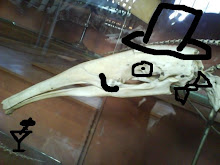There are 12 people on this paper. 12, from 8 different institutions. This is fairly typical for Science, Nature, Cell papers, and indeed any other high impact paper. People get put on papers to add weight to the research, or to embiggen friends, bosses and spouses. I have heard of at least one researcher who puts their partner on to papers, even when the partner in question has had nothing to do with the actual research, and conversely I know of students and technicians who have put the hours in to actually do the research for a paper, only to be thanked by being left off the paper, sometimes not even making the acknowledgments. These practices, whist being widespread, are dodgy at best and down right fraudulent at worst.
As I've said before, I'm just a lowly PhD student, and who am I to comment, but the whole situation leaves me saddened. Though, that said, if i was to be put on to a Science paper with out lifting a finger, would I get on my high horse and ride out into moral sunset? I doubt it.
I've copied the International Committee of Medical Journal Editors' guidelines on authorship below [3]. I'd be very surprised if all 12 authors on this paper fulfil all three criteria of the first point below, though I'd love to be wrong.
Authorship credit should be based on 1) substantial contributions to conception and design, or acquisition of data, or analysis and interpretation of data; 2) drafting the article or revising it critically for important intellectual content; and 3) final approval of the version to be published. Authors should meet conditions 1, 2, and 3.
When a large, multi-center group has conducted the work, the group should identify the individuals who accept direct responsibility for the manuscript (3). These individuals should fully meet the criteria for authorship defined above and editors will ask these individuals to complete journal-specific author and conflict of interest disclosure forms. When submitting a group author manuscript, the corresponding author should clearly indicate the preferred citation and should clearly identify all individual authors as well as the group name. Journals will generally list other members of the group in the acknowledgements. The National Library of Medicine indexes the group name and the names of individuals the group has identified as being directly responsible for the manuscript.
Acquisition of funding, collection of data, or general supervision of the research group, alone, does not justify authorship.
All persons designated as authors should qualify for authorship, and all those who qualify should be listed.
Each author should have participated sufficiently in the work to take public responsibility for appropriate portions of the content.
[1]Sutter et al, 2007, DOI: 10.1126/science.1137045
[2]Wang et al, 2006, DOI:10.1210/en.2006-0196
[3]http://www.icmje.org/ accessed 10/04/2007


1 comment:
Bagsy a co-authorship on any papers published by The Scientician which go on to change the world.
You bagsy these things, right?
Post a Comment